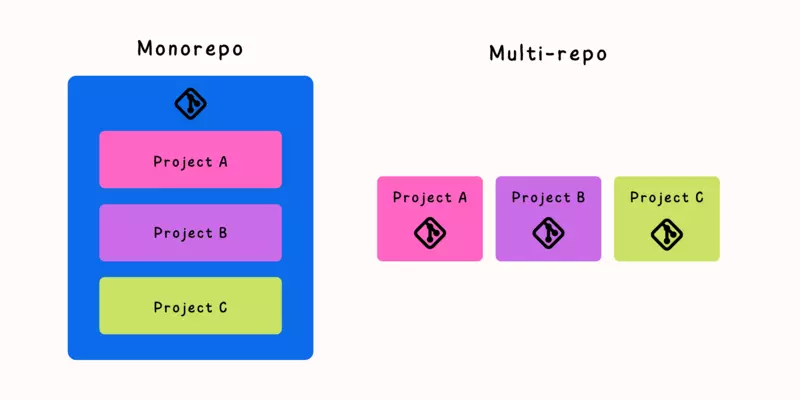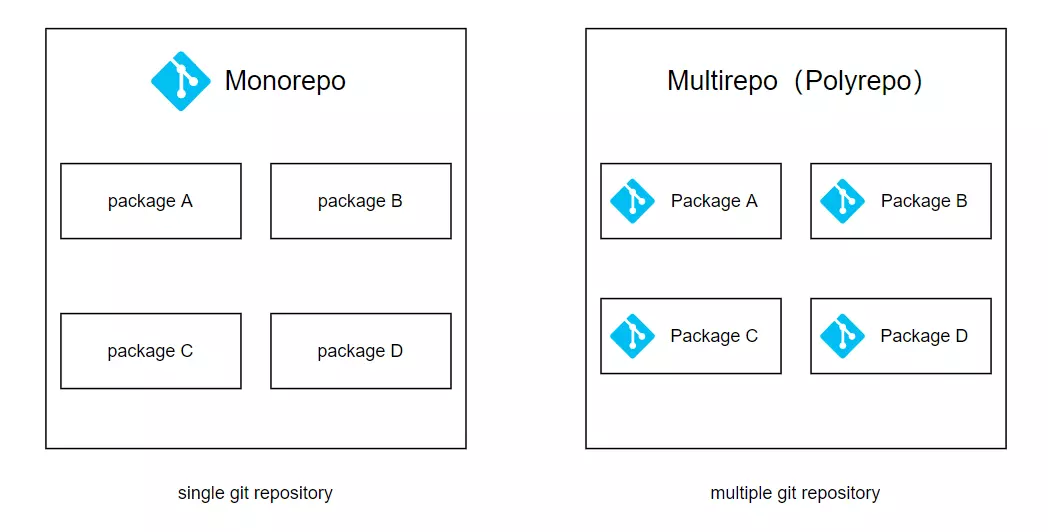
Monorepo and Polyrepo are two different approaches for organizing code repositories in software projects.
Monorepo (short for "monolithic repository") is a unified repository that contains all the code of a project and its dependencies. We use this method when we want to keep all the components of a project together.
On the other hand, Polyrepo (short for "multiple repositories") is an approach where different parts of a project are kept in separate repositories. Each repository contains code related to a specific module or component of the overall system and can be managed by separate teams. This approach is often used for smaller projects or by organizations with fewer developers or teams. Polyrepo can help keep the code repository small. It also makes it possible to assign separate versions for each component of the project.

In the field of microservices architecture, one of the initial project decisions is to choose one of these approaches to maintain microservices.
In Monorepo approach, all microservices along with their dependencies are kept in one repository. This approach can provide benefits such as easy code sharing, faster integration testing, and simplified version control. However, as the number of microservices increases, it can become challenging to manage the codebase and ensure that changes to one microservice do not inadvertently affect other services.
In the Polyrepo approach, each microservice is kept in its own repository, which allows more flexibility in the process of code changes and project deployment. This approach can provide independence for microservices and development teams. However, it can pose challenges in terms of dependency management, integrated versioning, and code sharing between microservices.
There are several reasons why organizations use the Monorepo approach for their software projects:
Simple code sharing: In Monorepo, all the code of a project is kept in one repository, as a result, access to all project components is made possible for all teams.
Unified Versioning: In Monorepo, it's easier to ensure that all components of a project use the same version of a library or dependency.
Faster integration testing: In Monorepo, all the codes of a project are located in one place, so the implementation of integration testing can be done faster and easier.
Easier refactoring: Refactoring code in Monorepo is generally easier. This can be especially important for large and complex projects. Because changing the code at one point of the program can cause problems in other parts.
Improve team collaboration process: In Monorepo, developers can easily see the overview of a project and collaborate between teams. This can help improve the overall quality of the code.
There are also several reasons why organizations use the Polyrepo approach for their software development projects:
Greater independence: In the Polyrepo approach, each microservice or component has its own repository, allowing greater independence between teams.
Easier Dependency Management: With the Polyrepo approach, each microservice or component has its own dependencies, which allows managing and updating specific dependencies without affecting other parts of the code.
Simple versioning: In the Polyrepo approach, each microservice or component has its own versions that are defined regardless of other parts of the project.
More flexible deployment: With the Polyrepo approach, each microservice or component can be deployed independently, enabling changes and updates to be implemented without affecting other parts of the project.
Easier Testing: In the Polyrepo approach, each microservice or component can be tested independently, which makes it easier to identify and fix bugs.

When deciding between Monorepo and Polyrepo, there are several factors to consider:
Project size and complexity: Monorepo can work well for larger and more complex projects, while Polyrepo may be better suited for smaller, more modular projects.
Structure of teams and how they collaborate: Monorepo can facilitate collaboration between teams because all code is kept in one place, while Polyrepo allows more independence between teams.
Deployment strategy: Monorepo can facilitate integrated deployment and integrated testing, while Polyrepo can facilitate independent deployment and testing.
Experience of developers: Developers may have different preferences and ways of working, so it is important to consider the experiences of developers when choosing these approaches.
Tools and infrastructure: Each approach may require different tools and infrastructure to manage and deploy, so it is important to consider the available resources and cost of implementing each approach.
Ultimately, the choice between Monorepo and Polyrepo depends on the specific needs and goals of the project and organization. It is important to carefully evaluate each approach and weigh its pros and cons before making a decision. It is also possible to use a hybrid approach, where some modules are kept in Monorepo and others in separate repositories, to strike a balance between the advantages of each approach.

I am Reza Babakhani, a software developer. Here I write my experiences, opinions and suggestions about technology. I hope that what I write is useful for you.
leave a comment